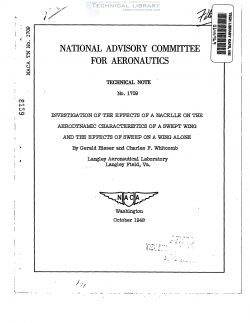naca-tn-1709
- Version
- 117 Downloads
- 3.32 MB File Size
- 1 File Count
- December 6, 2016 Create Date
- December 6, 2016 Last Updated
National Advisory Committee for Aeronautics, Technical Notes - Investigation of the Effects of a Nacelle on the Aerodynamic Characteristics of a Swept Wing and the Effects of Sweep on a Wing Alone

An investigation was conducted to determine the effects of a nacelle
on the aerodynamic characteristics of a swept wing and the effects of
sweep on a wing alone. The aerodynamic characteristics were determined
from force and pressure measurements and tuft studies at Mach numbers
of 0.13 to 0.61 for the wing-nacelle combination and at 0.13 to 0.70
for the wing alone. The angle of attack was varied from 0° to the
stalling angles at a Mach number of 0.13 and from -l.65° to 6° at the
higher Mach numbers.
The results showed that the measured variation of lift-curve slope
with sweep angle is in good agreement with theory up to 30° sweep, but
at greater sweep angles the theory apparently underestimates the effects
of sweep. The presence of the nacelle increased the lift-curve slope
about 10 percent with the wing at 15° sweep but decreased the slope
slightly at J45 sweep. The nacelle had no effect on the lift-curve
slope of the unswept wing. The presence of the nacelle did not
appreciably alter the stalling characteristics of the wing at sweep
angles of 15° or 45°, but for the unswept wing the addition of the
nacelle caused an appreciable reduction in the maximum lift coefficient
and in the angle of attack at maximum lift.
In general, for Mach numbers up to 0.61 the drag increment due to
the nacelle was lower for the swept configurations than. for the unswept
configurations.
The addition of the nacelle to the wing reduced the longitudinal
stability at all sweep angles. For both the wing alone and the wing-
nacelle combination, a marked increase in longitudinal stability
resulted from positive sweep, whereas only a small increase was
realized for negative sweep (-1150) .
When the wing was swept back or swept forward to an angle of 15°,
high pressure peaks and adverse pressure gradients occurred near the
leading edge of the wing at the acute Junction of the wing and nacelle.
Recent investigations have been conducted to evaluate the effects
of using sweep as a means of reducing and delaying the adverse effects
due to compressibility on the aerodynamic characteristics of a wing.
| File | Action |
|---|---|
| naca-tn-1709 Investigation of the Effects of a Nacelle on the Aerodynamic Characteristics of a Swept Wing and the Effects of.pdf | Download |
Comment On This Post